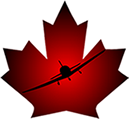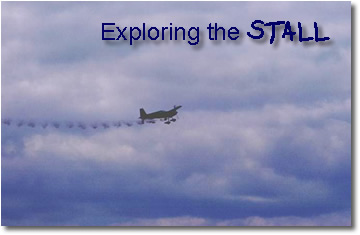 |
|
Exploring the Stall, Part I The Basic, Level StallThe aerodynamic stall is a very interesting phenomenon and an important one with which to be familiar. Most pilots are not particularly keen to stall their aircraft just for the fun of it, and a surprising number—I discover this doing checkouts—have not taken the time to stall an aircraft intentionally since their last flight test. Of course, we never want to stall an aircraft unintentionally at any time, but having a good understanding of the stall characteristics and the symptoms leading up to the stall for the aircraft you are flying can be information that might save your life. An aircraft wing stalls at a particular angle of attack. That’s the whole story. The stall is not a function of airspeed, although we commonly practice stall entry at low airspeed, nor is it a function of attitude, although we generally associate the stall with a nose up attitude as a result of our training sessions. A stall happens because the angle of attack of the wing—the angle between the chord line of the wing and the relative wind—has exceeded the critical angle. In training, I sometimes use the metaphor of ice formation: water freezes, under normal conditions, at 0º C. At 0.1º C, water is not frozen. It is the same with the stall. Below the critical angle of attack, the wing is not stalled. Above the critical angle, the wing stalls. How do we recover from a stall? We reduce the angle of attack. If we’re right side up, we move the stick forward and lower the nose. If we’re upside down, we pull the stick back and lower the nose. If we’re in a normal, outside turn, we ease the stick forward and lower the nose. In any situation, what we do to recover from the onset of a stall is reduce the angle of attack below the critical angle that is producing the stall. For those few aviators who still mess about with conventional gear aircraft, understanding and having an accurate feeling for the onset of the stall is very important. Every time we settle into a nice three-point landing we are, essentially, stalling the aircraft onto the runway. Most tailwheel aircraft are designed so that the angle of attack achieved when the aircraft is sitting on all three wheels is the critical angle of attack that results in a stalled condition. For the odd one with short legs, like the little Citabria flown by a friend of mine, the three-point landing can become an interesting challenge because, in the three-point attitude, the aircraft is not at the critical angle of attack. For tricycle gear aircraft, the stall angle is somewhat less critical for landing. The aircraft is generally not stalled onto the runway except by beginning students who may flair a bit high. Normally, with tricycle gear aircraft, we fly them onto the landing surface just above the stall to ensure positive control of the machine. With any aircraft, however, it is very important to know well the symptoms of an approaching stall so we can make positive decisions on how to proceed. If it is your intention to stall the aircraft, excellent. Proceed with the manoeuvre. If it is not your intention to stall the aircraft, notice the approaching stall and correct the problem by reducing the angle of attack. It’s like knowing, in the dark, where the edge of the stairs are at home. If you know exactly where the edge is you can approach it with confidence; if you are unsure, you may well step over by mistake and find yourself in deep, deep trouble. When we practice stalls in training, we do them at altitude where there will be no problems. Even if we do a poor job of recovering from the manoeuvre, we have plenty of altitude to play with and no harm will result. If, however, we inadvertently stall the aircraft low to the ground, on landing for example, we can find ourselves in a world of hurt. Add a touch of yaw to that picture and we are in real trouble. If you are flying an aircraft that is new to you or if it’s been a while since you practiced basic stalls, it might be an excellent idea to investigate them again. If you have any qualms about the manoeuvre, find an instructor you trust and feel comfortable flying with and ask him or her to take you up to practice a few stalls. Basic power-off stalls with no power and power-on recoveries are a great place to start. Complete your HASEL or HALT checks, making certain all is safe and correct. Do a good lookout. Remember that this manoeuvre will lose some altitude so have a good look below. Apply the carburetor heat, ease the power back to idle, and hold your altitude by increasing the angle of attack. There is no need to aggressively pull back on the stick. Doing so actually makes it more difficult to see and feel and hear the approach to the stall which is what we really want to understand and know. Pick a reference point, if at all possible, so you can monitor closely any yaw that may develop. A cloud or a mountain peak will work just fine. If it is a clear, beautiful, blue sky, you may have to monitor the directional gyro or magnetic compass, but these are not as sensitive as your eye on a fixed point outside. We want to avoid any unintentional yaw if we can. As the aircraft approaches its critical angle of attack, take note of the developing symptoms. You will see a slight nose up attitude. If your aircraft is equipped with one, you will hear the stall warning begin about 10 Knots or so ahead of the actual stall. You will begin to feel a slight buffeting on the stick caused by the disturbed air coming off the wings and hitting the horizontal stabilizer. The controls will feel quite sluggish and unresponsive. You will note the quiet resulting from reduced airflow over the aircraft and the idling engine. At the stall itself, the nose will drop slightly. If you have not been attentive to the rudder controls and have allowed yaw to develop, the aircraft may show you it has been yawing by dropping a wing. So, we’ve achieved a nice, power-off stall. Let’s recover. If we wish to recover from the stall without power, we simply reduce the angle of attack. Once again, no need to be overly aggressive. We don’t need to bounce our poor instructor’s head off the headliner. We simply need to reduce the angle of attack below the critical angle so the aircraft is flying again. Normally, a slight nose down attitude will do the job nicely. We’re now in a gentle glide. If we wish to recover with power, we reduce the angle of attack and give the aircraft full power, being alert to control the adverse yaw produced by torque and slipstream. Don’t forget to close the carburetor heat. Normally, lowering the nose to approximately cruise attitude or slightly below will be sufficient if we are using power. As soon as we can confirm positive airspeed, we can regain our lost altitude and carry on. Practicing stalls so you can learn, understand and know the stall characteristics of your aircraft will give you a sense of control and security. You will know where the edge is and will be able to approach it with confidence. You will know the symptoms of the approaching stall and know how and when to modify your inputs to either produce or avoid the stall as required. Your landings will improve, your flying will improve and your sense of your own knowledge and skills will boost your confidence. The basic stall is a simple yet elegant and important procedure. If you’re not completely comfortable with stalls, now is an excellent time to find whatever assistance you may need to develop a positive relationship with the manoeuvre. You’ll be glad you did.
|



